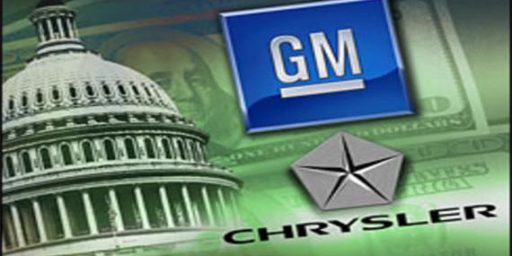Incentives Matter
No really, they do even though many politicians and policy makers act and talk like they don’t. Tyler Cowen points to an interesting incident in 1998 that while small may have been a contributing factor to the current financial mess we are in.
THE financial crisis is a result of many bad decisions, but one of them hasn’t received enough attention: the 1998 bailout of the Long-Term Capital Management hedge fund. If regulators had been less concerned with protecting the fund’s creditors, our current problems might not be quite so bad.
Long-Term Capital was advised by finance quants, or quantitative analysts, who made a number of unsound, esoteric bets, including investments in interest rate derivatives. When Russia’s inability to pay its debts roiled global markets, the fund, saddled with high-leverage and off-balance-sheet obligations, was near collapse.
Because Long-Term Capital owed large sums to banks and other financial institutions, the Federal Reserve Bank of New York organized a consortium of companies to buy it out and cover the debts. Alan Greenspan, then the Fed chairman, eased monetary policy to restart capital markets, which were starting to freeze up. Long-Term Capital’s shareholders were wiped out, but none of the creditors took losses.
[…]
With the Long-Term Capital bailout as a precedent, creditors came to believe that their loans to unsound financial institutions would be made good by the Fed — as long as the collapse of those institutions would threaten the global credit system. Bolstered by this sense of security, bad loans mushroomed.
[…]
With the Long-Term Capital bailout as a precedent, creditors came to believe that their loans to unsound financial institutions would be made good by the Fed — as long as the collapse of those institutions would threaten the global credit system. Bolstered by this sense of security, bad loans mushroomed….Such funds hadn’t previously been brought under regulatory protection this way. After the episode, financial markets knew that even relatively obscure institutions — through government intervention — might be able to pay back bad loans.
The major creditors of the fund included Bear Stearns, Merrill Lynch and Lehman Brothers, all of which went on to lend and invest recklessly and, to one degree or another, pay the consequences. But 1998 should have been the time to send a credible warning that bad loans to overleveraged institutions would mean losses, and that neither the Fed nor the Treasury would make these losses good.
Another example of the failure of discretionary policy. At precisely the moment when the government needed to send a strong signal that bailouts were not the order of the day, it sent precisely the opposite signal. Basically, if you are going to engage in reckless loans make sure you do it in a really big way and bring in as many big financial institutions as possible. This will help ensure a bailout if your gambles don’t quite pan out.
What would have happened without a Fed-organized bailout of Long-Term Capital? It remains an open question. An entirely private consortium led by Warren E. Buffett might have bought the fund, but capital markets might still have frozen because of the realization that bailouts were not guaranteed.
And Fed inaction might have had graver economic consequences, especially if a Buffett deal had fallen through. In that case, a rapid financial deleveraging would have followed, and the economy would have probably plunged into recession. That sounds bad, but it might have been better to have experienced a milder version of a downturn in 1998 than the more severe version of 10 years later.
But what the Hell, lets go ahead and bailout out all these institutions that correctly interpreted the governments signal. Are we setting ourselves up for an even larger mess in another 10 years? Possibly.
In 1998, there was no collapsed housing bubble, the government’s budget was in surplus rather than deficit, bank leverage was much lower, and derivatives markets were smaller and less far-reaching. A financial crisis related to Long-Term Capital, however painful, probably would have been easier to handle than the perfect storm of recent months.
The ad hoc aspect of the bailout created a precedent for what has come to be called “regulation by deal” — now the government’s modus operandi. Rather than publicizing definite standards and expectations for bailouts in advance, the Fed and the Treasury confront each particular crisis anew. Decisions are made as to whether a merger is possible, whether a consortium can be organized, what kind of loan guarantees can be offered and what kind of concessions will be extracted in return. So far, every deal — or lack thereof, in the case of Lehman Brothers — has been different.
In other words the spotty, inconsistent and completely by-the-seat-of-their-pants approach to this mess is a bad idea. One of the things about government policy is that it will cause various actors in the economy to change their behavior. If you tell everyone that their stock investments can’t lose money, the government will make any losses whole, but that people can keep any gains, what do you think will happen? Will people be cautious and careful in their investing or will they become more risky looking for the big payouts all the while knowing that big losses are not a worry? I’m thinking the latter is more likely to be what we will see. And that is what we have in effect done. We have eliminated the costs associated with risk taking or at least reduced them. So what will be the result down the road? More or less reckless behavior?
And once you go down this road it is hard to convince everyone that now…now you are serious. No more bailouts. This was part of the problem during the Great Depression. After WWI countries went back on the Gold Standard to ensure a stable currency and reign in inflation. It worked…for awhile. Then when deflation set in, speculators started making bets as to when a currency would go off the Gold Standard. After all they’d gone off it before, so it seems inevitable they’d do it again in the face of economic crisis. So now the government has already sent a signal back in 1998…if you are big enough, and have involved enough other large financial institutions and even governments you’ll get a bailout. Now to send a signal that indicates no more bailouts will likely require that financial institutions fail, that there is a deeper recession than if it had been done in 1998, and so forth. The longer we go down this road, the harder it will be to get away from it.
And there are costs to this kind of discretionary policy,
While there are some advantages to leaving discretion in regulators’ hands, this hasn’t worked out very well. It has become increasingly apparent that the market doesn’t know what to expect and that many financial institutions are sitting on the sidelines, waiting to see what regulators will do next. Regulatory uncertainty is stifling the ability of financial markets to engineer at least a partial recovery.
The bailouts, without any sort of rules (there is that word again…rules, rather than discretion as I’ve argued in several places before) on how bailouts are going to work makes for simply rotten policy. Some might be saying, “Hey nobody likes this, how likely are financial institutions to repeat this?” Well, didn’t many institutions that got bailed out just pay upper management bonuses? And weren’t these same institutions and upper management riding “high on the hog” just a little over a year ago? When bonuses are tied to annual performance and are generous even in harsh economic times, do you think they’ll be more cautious in the future?






More evidence that George Bush really was president in 1998, I guess.
I think the best answer to this was that there wasn’t a “bailout” in any real sense. No public monies were paid out. Wall Street was just “jawboned” into saving one of its members.
If that’s all it took again in 2008, I would have been pretty happy actually.
(So no, there was no bailout “signal.” None of my (or your) taxes went into the LTCM deal.)
That is what you call strong arm tactics? So a mugger is really just a “jawboner”?
What was the stick they used? I really doubt that it was Guantanamo.
You really are clueless about the New York Fed aren’t you? It is the most powerful Fed Bank. It has a permanent seat on the FMOC and is typically its Vice Chairman, its current is Thomas Geithner the incoming Sec. Treasury. Geithner was the guy who arranged the sale of Bear Stearns.
That isn’t usually the kind of person you want to piss off.
Serious people with understanding of the financial markets understand that the LT Credit situation was a HUGE signal to financial market participants. Go read David Smick’s The World is Curved for insight.
It is fashionable these days to blame the mortgage/liquidity mess on Bush. One current canard is that the lax regulatory environment he facilitated is the cause. We call these people 1) partisan, 2)ignorant or 3)both. The single most important regulatory issue relevant to the current mess is the repeal of Glass Steagal, which allowed traditional commercial banks to pursue their investment banker wannabe tendencies. We know what happened when they became syndicators, and stopped holding the loan risk on their own books. GS was repealed during the term of a certain William Jefferson Clinton.
The blame Bush crowd also conveniently forgets that the root cause of the mortgage mess, a social policy imlemented in the good name of “affordable housing” encouraged (in fact, strongarmed) lenders to make bad loans – excuse me, “sub-prime” loans, for fear of criminal redlining charges. That run-up was initiated by Bill Clinton’s HUD, run by Andrew Cuomo.
And of course LTCM signaled that the Feds would stand behind the entire financial system if all hell broke loose. LTCM was 1998. Inconvenient facts, indeed.
All this blaming of the guy who was in the chair when things finally blew up is analogous to a life-long smoker who finds out he has lung cancer, but then wants to blame the doctors who might not have read the imaging studies correctly, or soon enough, or wants to blame the oncologist who didn’t get just the right chemo regimen. But blame the root cause – smoking? – no way.
I of course understand the politics of blaming Bush. But you know you are conversing with a rank partisan hack uninterested in understanding or learning valuable lessons from policy mistakes when you hear “blame Bush, Bush, Bush.”